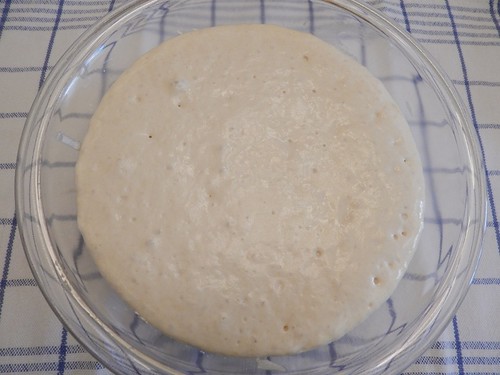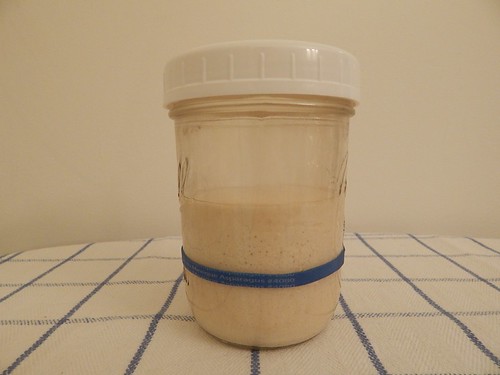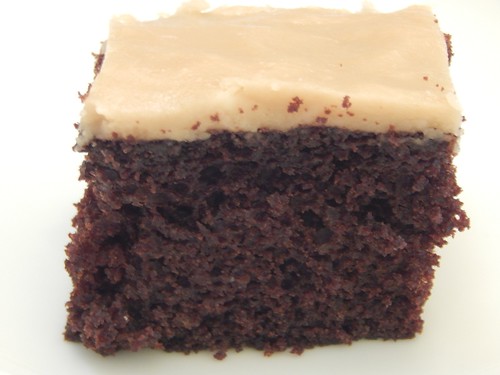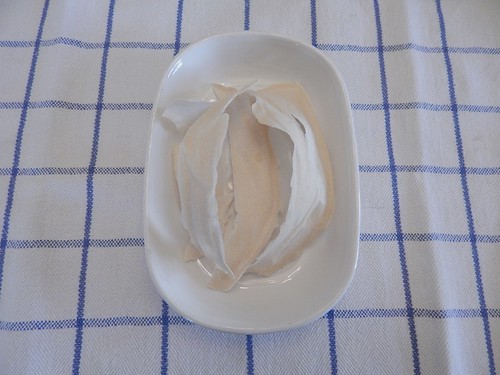
At first the sourdough starter was very active, doubling rapidly and enthusiastically. On one fermentation cycle it burped hard enough to knock its waxed paper cover askew. (I assume its high activity is because my kitchen has lots of happy microflora floating about from making yogurt, which I started during the 2017 FIJ Challenge.) Eventually a thin layer of hooch formed, and as I wasn't interested in drinking it or using it to brew lambic beer, but did want the starter to calm down, I stirred the hooch in and began small starter maintenance. The alcohol should inhibit the yeasts and encourage the lactobacilli. Even so, the starter happily doubled at room temperature in less than three hours, as shown below. I switched from fermenting in a trifle bowl covered with waxed paper to Mason jars in anticipation of storing the starter in the refrigerator.


Tending a sourdough starter produces a lot of discard, which I put to work. First, I made Buttery Sourdough Sandwich Biscuits. Remarkably, I could feel the sourdough rising as I cut out the biscuits – and my nicely formed biscuits slumped during baking. Ah well, Dance 10, Looks 3 – the results are very tasty. I'd definitely make them again, although maybe next time I'd reduce the amount of butter.

At room temperature the small starter replenished almost as fast as I could bake. So I made a Sourdough Chocolate Cake (with brown sugar icing) for a church potluck. It's a heavy oil cake with a coarse crumb and a nice cocoa flavor, with a faint sourdough tang (super close up below to show the crumb). When I focus on the tang, it seems subtly different than that of a yogurt or sour cream cake, which are made with fermented milk, while sourdough is fermented grain. Both make food more easily digested, and the nutrients more readily available. Makes me want to try subbing coconut oil and rye flour in the cake, the coconut oil for flavor and the rye flour for both flavor and the yeasts carried in its bran. Rye flour is legend among sourdough enthusiasts.

One sourdough legend that I ignored was a ban on metal, reminiscent of tales of the effects of cold iron on fairies – I used stainless steel without ill effect. I imagine sourdough wisdom is a bit like dye lore, accumulated over time with careful observation but no modern technology. I can see how more reactive metals such as copper or aluminum might have dramatic reactions with sourdough, which after all is acetic.

To store my sourdough starter, I'm using modern technology in the form of a new-fangled refrigerator. But I'm also trying the old school technique of drying a smear of starter on a piece of parchment paper and keeping the resulting chips in a cool, dry place. The smear contracted as it dried, forming long curved pieces that turned the flat parchment paper into a rippled hyperplane. I'll try reviving it some time in the future.
So that's my fermentation February. I've noticed fermentation projects have a sorcerer's apprentice aspect to them – unless kept well in hand, they have a tendency to increase rapidly and become overwhelming (!), not to mention one project suggests another. (Or maybe something about fermentation appeals to the more obsessive aspects of one's personality. Huh, I've been trying to do some shadow work.) I'd like to try making kimchi, and may yet do so, but also wanted to post this wrapup in time for the FIJ deadline. So, onward to March and herbs.
No comments:
Post a Comment